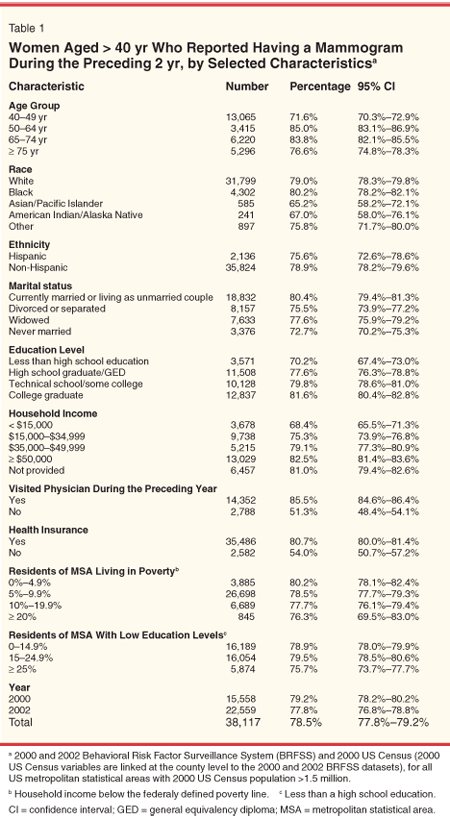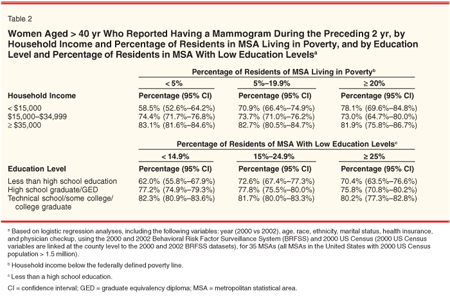Breast Cancer Screening and Socioeconomic Status: 35 Metropolitan Areas, 2000 and 2002
Studies have suggested that women with low incomes residing in metropolitan areas might be less likely to be screened for breast cancer than more affluent women residing in the same areas.[1,2] However, few studies have examined the associations between breast cancer screening and both individual and area-based measures of socioeconomic status among women in metropolitan areas.[3,4] To examine these associations, the Centers for Disease Control (CDC) analyzed the percentage of women who had a mammogram by using individual data (ie, household income and education level) from the 2000 and 2002 Behavioral Risk Factor Surveillance System (BRFSS) surveys and area-based data (ie, percentages classified as living in poverty [annual family income below the federally defined poverty line] or at a low education level [less than a high school education]) from the 2000 US Census.
Studies have suggested that women with low incomes residing in metropolitan areas might be less likely to be screened for breast cancer than more affluent women residing in the same areas.[1,2] However, few studies have examined the associations between breast cancer screening and both individual and area-based measures of socioeconomic status among women in metropolitan areas.[3,4] To examine these associations, the Centers for Disease Control (CDC) analyzed the percentage of women who had a mammogram by using individual data (ie, household income and education level) from the 2000 and 2002 Behavioral Risk Factor Surveillance System (BRFSS) surveys and area-based data (ie, percentages classified as living in poverty [annual family income below the federally defined poverty line] or at a low education level [less than a high school education]) from the 2000 US Census.
This report summarizes the results of those analyses, which suggested that, among women in 35 metropolitan statistical areas (MSAs),* those with annual household incomes < $15,000 were less likely to have had a mammogram than more affluent women (especially in areas where a greater proportion of women were affluent) and those without a high school education were less likely to have had a mammogram than women with more education (especially in areas where a greater proportion of women had higher education levels). Studies are needed to determine how to increase the percentage of women having mammograms among women in low-income and low-education -populations.
The Behavioral Risk Factor Surveillance System is a state-based, random digit-dialed telephone survey of the noninstitutionalized, US civilian population aged ≥ 18 years.[5] During 2000 and 2002, BRFSS interviews were conducted with 251,269 women. Data from 2000 and 2002 were used to provide the best match between individual-level information and MSA data from the 2000 US Census. Weights were used to adjust for differences in probability of selection, nonresponse, and noncoverage. The Council of American Survey Research Organizations estimated median response rates among reporting states in 2000 and 2002 were 48.9% and 58.3%, respectively.[5] Questions were asked regarding general health status, demographic and socioeconomic characteristics, and breast cancer screenings. Female respondents were asked, "Have you ever had a mammogram?" Those who said "yes" were then asked, "How long has it been since you had your last mammogram?"
MSA Classification
Self-reported county of residence was used to classify respondents as residents of MSAs using Office of Management and Budget definitions for MSAs.[6] To reduce the heterogeneity of the MSAs and ensure a sufficient number of respondents in each, only BRFSS respondents who resided in MSAs with populations of ≥ 1.5 million in 2000 were included in this analysis. The 35 MSAs included in this analysis ranged in population from 1,500,741 to 18,323,002. Analy ses were limited to 38,117 women aged ≥ 40 years with no missing information about recent mammography. Area-based data regarding SES (ie, percentage of residents in an MSA classified as living in poverty or having a low education level) were obtained from the 2000 US Census and categorized using previously described cutpoints.[7] Percentage of residents living below the poverty level was based on the 1999 federal definition of a poverty area. Rates for having a mammogram during the preceding 2 years were calculated with combined data from 2000 and 2002.
In examining the bivariate associations between screening and both demographic and health factors, the levels of statistical significance were obtained using Pearson's chi-square tests; 95% confidence intervals (CIs) and P values were calculated. Multivariate analyses of the associations between individual-level and area-based data and breast cancer screening were conducted using logistic regression analyses that employed the following variables: year (2000 vs 2002), age, race, ethnicity, marital status, health insurance, and physician checkup during the preceding year.
Effect of Income and Education
Approximately 9.6% of the women aged ≥ 40 years who responded had household incomes of < $15,000 per year, a level just above that identified by 1999 federal poverty level guidelines as 100% of poverty ($13,410) for a family of three with one member aged < 18 years[8]; 23.7% had household incomes of $15,000 to $34,999 per year, or approximately $1,500 above 250% of the 1999 federal poverty level for a family of three with one member aged < 18 years. Among the participants, 11.8% had less than a high school education, 8.0% had never been married, and 9.1% had no health insurance.

Overall, 78.5% of women aged ≥ 40 years reported having a mammogram during the preceding 2 years (Table 1). Among women who reported annual household incomes of < $15,000, 68.4% (95% CI = 65.5%-71.3%) received a mammogram in the preceding 2 years; 75.3% (95% CI = 73.9%-76.8%) of women with household incomes of $15,000-$34,999 and 82.5% of women with household incomes of ≥ $50,000 (95% CI = 81.4%-83.6%) had received a mammogram in the preceding 2 years. Women with less than a high school education, those who were never married, and those who had no health insurance also had lower mammography rates than those who were college graduates, married, or had health insurance. The percentages of residents in MSAs who were living in poverty or who had a low education level were both inversely associated with breast cancer screening.
Women with annual household incomes of < $15,000 per year were less likely to have received a breast cancer screening during the preceding 2 years than more affluent women, especially women with incomes in more affluent areas (Table 2). Similarly, women without a high school education were less likely to receive breast cancer screening than women with more education, especially in areas where a larger proportion of women had more education. These findings were confirmed by multivariate analysis (P < .0001).

Reported by: S.S. Coughlin, PHD, J. King, MPH, T.B. Richards, MD, D.U. Ekwueme, PHD, Division of Cancer Prevention and Control, National Center for Chronic Disease Prevention and Health Promotion, CDC.
Editorial Note From the CDC
The findings in this report confirm those from previous studies[1,2] that suggested women with lower incomes in metropolitan areas of the United States are less likely to have mammograms than more affluent women in those metropolitan areas. Moreover, these findings suggest that women with low incomes in more affluent areas are less likely to have mammograms than women with low incomes in less affluent areas. Reasons for this disparity are uncertain. The areas in which persons live might affect screening use because of varying living costs, education and employment opportunities, access to health care, and other factors (eg, cost, proximity, and acceptance of medical services, and availability of public transportation or public clinics).[8,9]
Studies are needed to examine the extent to which breast cancer screening is being provided to priority populations (eg, women not routinely screened for breast cancer) at the community level. Addressing this question might require development of improved methods for obtaining subcounty estimates for the locations of priority populations and comparing these locations with the locations where screening tests currently are being provided (ie, gap analysis).
The findings in this report are subject to at least four limitations. First, the ability to identify combinations of factors influencing screening utilization was limited by the variables included in the analytic dataset and by the large geographic units involved in MSA analysis. Future analyses might include additional variables related to utilization of cancer screening services and neighborhood characteristics at the census-tract or block-group level. Second, women in households without telephones were excluded, and only approximately half of potential respondents agreed to participate. Third, self-reported information regarding breast cancer screening might differ from information obtained from records of health-care providers. Validation studies have suggested that patients tend to overreport their use of screening and underreport the time lapse since their last screening.[10] Finally, results of this study might not be generalizable to smaller metropolitan areas.
Results from this study indicate that women with low incomes in metropolitan areas with ≥ 1.5 million population are less likely to have a mammogram than more affluent women. Many women with annual household incomes of < $15,000 are eligible for Medicaid; however, Medicaid providers and clients are likely to have urgent needs that take precedence over breast cancer screening. Women not eligible for Medicaid who do not have employer-sponsored health care can receive breast and cervical cancer screening through CDC's National Breast and Cervical Cancer Early Detection Program (available at www.cdc.gov/cancer/nbccedp), which funds all 50 state health agencies, the District of Columbia, 13 tribal organizations, and four territories. Analyses of cancer screening by measures of SES and other factors might help direct resources to areas of greatest need so that resources can be most effective and beneficial.
References:
1. Mickey RM, Durski J, Worden JK, et al: Breast cancer screening and associated factors for low-income African-American women. Prev Med 24:467-476, 1995.
2. Garbers S, Jessop DJ, Foti H, et al: Barriers to breast cancer screening for low-income Mexican and Dominican women in New York City. J Urban Health 80:81-91, 2003.
3. Rakowski W, Pearlman D, Rimer BK, et al: Correlates of mammography among women with low and high socioeconomic resources. Prev Med 24:149-158, 1995.
4. Nelson DE, Bolen J, Marcus S, et al: Cancer screening estimates for U.S. metropolitan areas. Am J Prev Med 24:301-309, 2003.
5. CDC: Behavioral Risk Factor Surveillance System: BRFSS. Atlanta, US Department of Health and Human Services, CDC; 2005. Available at www.cdc.gov/brfss. Accessed July 19, 2006.
6. US Census Bureau: Metropolitan statistical areas and components, November 2004. Washington, DC: US Census Bureau; 2005. Available at www.census.gov/population/ estimates/metro-city/List4.txt. Accessed July 19, 2006.
7. Krieger N, Chen JT, Waterman PD, et al: Geocoding and monitoring of US socioeconomic inequalities in mortality and cancer incidence: does the choice of area-based measure and geographic level matter? The Public Health Disparities Geocoding Project. Am J Epidemiol 156:471-482, 2002.
8. Berk ML, Cunningham P, Beauregard K: The health care of poor persons living in wealthy areas. Soc Sci Med 32:1097-1103, 1991.
9. Benjamins MR, Kirby JB, Bond Huie SA: County characteristics and racial and ethnic disparities in the use of preventive services. Prev Med 39:704-712, 2004.
10. Caplan LS, McQueen DV, Qualters JR, et al: Validity of women's self-reports of cancer screening test utilization in a managed care population. Cancer Epidemiol Biomarkers Prev 12:1182-1187, 2003.